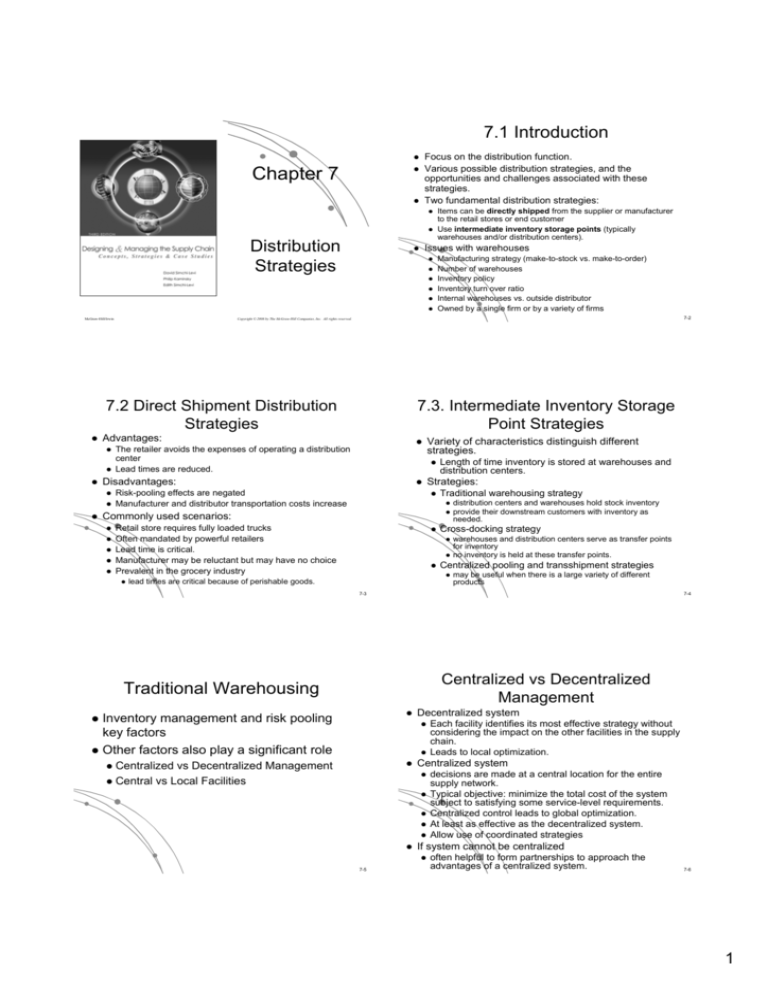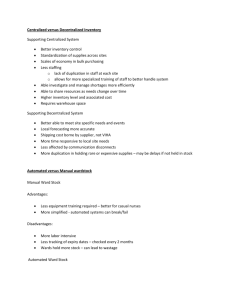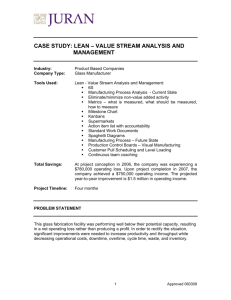
7.1 Introduction
Focus on the distribution function.
Various possible distribution strategies, and the
opportunities and challenges associated with these
strategies.
Two fundamental distribution strategies:
z
z
Chapter 7
z
z
z
Distribution
Strategies
Issues with warehouses
z
z
z
z
z
z
z
McGraw-Hill/Irwin
7-2
z
z
z
The retailer avoids the expenses of operating a distribution
center
Lead times are reduced.
z
Variety of characteristics distinguish different
strategies.
z
Disadvantages:
z
z
7.3. Intermediate Inventory Storage
Point Strategies
Advantages:
z
z
Risk-pooling effects are negated
Manufacturer and distributor transportation costs increase
z
z
z
z
z
Traditional warehousing strategy
z
z
Retail store requires fully loaded trucks
Often mandated by powerful retailers
Lead time is critical.
Manufacturer may be reluctant but may have no choice
Prevalent in the grocery industry
z
Length of time inventory is stored at warehouses and
distribution centers.
Strategies:
Commonly used scenarios:
z
Manufacturing strategy (make-to-stock vs. make-to-order)
Number of warehouses
Inventory policy
Inventory turn over ratio
Internal warehouses vs. outside distributor
Owned by a single firm or by a variety of firms
Copyright © 2008 by The McGraw-Hill Companies, Inc. All rights reserved.
7.2 Direct Shipment Distribution
Strategies
z
Items can be directly shipped from the supplier or manufacturer
to the retail stores or end customer
Use intermediate inventory storage points (typically
warehouses and/or distribution centers).
z
Cross-docking strategy
z
z
z
warehouses and distribution centers serve as transfer points
for inventory
no inventory is held at these transfer points.
Centralized pooling and transshipment strategies
z
lead times are critical because of perishable goods.
distribution centers and warehouses hold stock inventory
provide their downstream customers with inventory as
needed.
may be useful when there is a large variety of different
products
7-3
7-4
Centralized vs Decentralized
Management
Traditional Warehousing
z
Inventory management and risk pooling
key factors
z Other factors also play a significant role
z
z
z
Decentralized system
z
z
z
Centralized vs Decentralized Management
Central vs Local Facilities
Centralized system
z
z
z
z
z
z
decisions are made at a central location for the entire
supply network.
Typical objective: minimize the total cost of the system
subject to satisfying some service-level requirements.
Centralized control leads to global optimization.
At least as effective as the decentralized system.
Allow use of coordinated strategies
If system cannot be centralized
z
7-5
Each facility identifies its most effective strategy without
considering the impact on the other facilities in the supply
chain.
Leads to local optimization.
often helpful to form partnerships to approach the
advantages of a centralized system.
7-6
1
Central vs. Local Facilities
z
z
z
z
A Hybrid Decision
Centralized facilities
Employ both fewer warehouses and distribution centers
Facilities are located further from customers.
Some products use centralized strategy
while others use local strategy
z Not an either or decision
z Varying degrees of centralization and
localization due to the varying levels of
advantages and disadvantages
z
Other factors:
z
z
z
z
z
Safety stock. Lower safety stock levels with centralized
facilities
Overhead. Lower total overhead cost with centralized facilities
Economies of scale. Greater economies of scale with
centralized facilities
Lead time. Lead time to market reduced with local facilities
Service.
z
z
z
Utilization of risk pooling better with centralized
Shipping times better with local
Transportation costs.
z
z
Costs between production facilities and warehouses higher with
local
Costs from warehouses to retailers lesser with local
7-7
7-8
Cross-Docking
z
z
z
z
Popularized by Wal-Mart
Warehouses function as inventory coordination
points rather than as inventory storage points.
Goods arriving at warehouses from the
manufacturer:
z
z
z
Issues with Cross-Docking
z
z
are transferred to vehicles serving the retailers
are delivered to the retailers as rapidly as possible.
z
Goods spend very little time in storage at the
warehouse
z
z
z
Require a significant start-up investment and are
very difficult to manage
Supply chain partners must be linked with
advanced information systems for coordination
A fast and responsive transportation system is
necessary
Forecasts are critical, necessitating the sharing
of information.
Effective only for large distribution systems
z
Often less than 12 hours
Limits inventory costs and decreases lead times
z
Sufficient volume every day to allow shipments of fully
loaded trucks from the suppliers to the warehouses.
Sufficient demand at retail outlets to receive full
truckload quantities
7-9
7-10
Centralized Pooled Systems
Perform Better
Inventory Pooling – GM Example
z
z
z
z
1,500 Cadillacs parked at a regional distribution
center in Orlando
Await delivery to dealers statewide within 24
hours
10% to 11% sales loss because a car is not
available…
Test program expected to:
z
z
z
For the same inventory level, a centralized system
provides:
z
z
z
higher service level
higher sales
Push-pull supply chain
z
Moving from a push supply chain
z
To a push-pull supply chain
z
improve customer service
boost sales of Cadillacs by 10%
z
z
Dealers pull from regional distribution centers.
Implications:
z
z
7-11
Dealers have to order before demand is realized
End consumers will see better customer service
More cars are available to them.
7-12
2
Example of Inventory Pooling
Other Factors
z
z
z
z
Will GM sell more cars to GM dealers?
Total number of cars ordered by dealers will not
necessarily increase, even as customer service
increases.
z
z
What about the dealers?
z
z
Dealers have access to more inventory
z
z
Two retailers face random demand for a single
product.
No differences between the retailers
Compare two systems
z
Potentially can sell more.
z
Levels out the playing field between dealers.
z
centralized pooled system,
z
Small dealers would favor such a system Competitive
advantage of large dealers wiped out
decentralized system
z
z
retailers together operate a joint inventory facility
take items out of the pooled inventory to meet demand.
each retailer individually orders from the manufacturer
to meet demand
In both systems, inventory is owned by the
retailers
7-13
7-14
The Two Systems
Other Data
Wholesale price = $80 per unit
z Selling price = $125 per unit
z Salvage value = $20 per unit
z Production cost = $35 per unit
z
FIGURE 7-10: Probabilistic
demand faced by each retailer
FIGURE 7-9: The centralized
and decentralized systems
7-15
7-16
Customer Search
Costs and Profits in the Two Systems
z
Decentralized system
z
z
z
z
z
z
Each dealer orders 12,000 units
Expected profit per dealer = $470,000, Total =
$940,000
Expected sales = 11,340 units, Total = 22,680 units
Manufacturer profit = $1,080,000
Switches to another dealer
z Helps the manufacturer sell more products
z
z
Centralized system
z
z
z
z
If the customer arrives at a dealer and
does not find the item
Two dealers together will order 26,000 units
Total expected profit = $1,009,392
Joint expected sales = 24,470 units
Manufacturer profit = $1,170,000
Which system is better under customer
search?
z
7-17
No impact on the centralized system
7-18
3
z
Impact on Decentralized System
Nash Equilibrium (Game Theory)
If a dealer knows that its competitors do not keep
enough inventory
z
z
this dealer should raise the inventory level to satisfy:
z
z
z
z
this dealer will reduce the inventory level
z
z
z
If a dealer knows that its competitors has significant
inventory
z
z
its own demand
demand of customers who initially approach other dealers
with limited inventory.
If two competitors are making decisions,
they have reached Nash equilibrium if they
have both made a decision
It is not likely to see customers who switch
Both have decided on an amount to order
neither can improve their expected profit by
changing the order amount if the other dealer
doesn’t change his order amount.
Dealer’s strategy depends on its competitor’s
strategy.
Dealers may/may not know their competitor strategy
z
z
not clear how they decide on their inventory level.
not clear about the impact of search on the manufacturer
7-19
7-20
Example
z
z
z
Best Response with α=90%
α = percentage of customers that search the
system
Each retailer can determine what their effective
demand will be if the other retailer orders a
specific amount.
Based on this information, they can calculate
how much they should order given any order by
their competitors.
z
Best response
FIGURE 7-11: Retailers’ best response
7-21
7-22
Nash Equilibrium of the System
z
z
z
z
z
z
z
z
z
z
Decentralized and Centralized
Systems for Search Level of 90%
Retailer one orders about 20,000 units, retailer two will
respond by ordering about 12,000 units
If this is the case, then retailer one should modify its
strategy and reduce the order quantity
No retailer has an incentive to modify its strategy
They order amounts associated with the intersection of
the two curves.
Optimal order quantity for each retailer = 13,900 units
Total expected profit for each retailer = $489,460
Total expected profit = $978,920
Total expected sales = 25,208
Total amount ordered from the manufacturer = 27,800
Manufacturer’s profit = $1,251,000.
z
z
z
7-23
Strategy
Retailers
Manufacturer
Total
Decentralized
978,920
1,251,000
2,229,920
Centralized
1,009,392
1,170,000
2,179,392
Centralized system does not dominate the decentralized
system.
Retailers prefer the centralized system
Manufacturer’s profit is higher in the decentralized system
7-24
4
As α Increases
As α Increases
z
Each retailer’s order quantity and profit
increases
z Retailers’ total expected profit will be
higher in the centralized pooling system
than in the decentralized system.
z
With larger α
retailers will order more in a decentralized
system
z manufacturer will prefer a decentralized
system
z retailers will prefer a centralized system
z
z
With smaller α
manufacturer will order less in a decentralized
system
z both the retailers and the manufacturer will
prefer a centralized pooling system.
z
7-25
7-26
Effect of α on Amounts Ordered
Critical Search Level
z
Presence of a critical search level
manufacturer prefers the centralized system
below the level
z otherwise, manufacturer prefers the
decentralized system.
z
z
Manufacturer always prefers a higher
search level
FIGURE 7-12: Amount ordered by dealers as a function of the search level
7-27
7-28
How Can the Search Level Be
Increased?
z
Shipment of items between different
facilities at the same level in the supply
chain to meet some immediate need
z Occurs mostly at the retail level
z Can be achieved:
z
Increase brand loyalty
z
z
Transshipment
customers will more likely search for a particular
brand at another retailer if their first choice does not
have the product in inventory.
Information technology initiatives to increase
communication between retailers
z
z
with advanced information systems
z Shipping costs are reasonable
z Retailers have same owner
z
increases the ease with which customers can search
in the system
higher likelihood that customers will search in the
system
7-29
7-30
5
Retailers with Different Owners
Which Strategy to Adopt?
May not want to do transshipments
Distributor Integration strategies may be
adopted
z Not clear regarding inventory levels
z
z
z
z
z
Different approaches for different products
Factors:
Customer demand and location
Service level
z Costs => transportation & inventory costs
z Demand Variability
z
z
A retailer’s strategy depends on competitors’
strategies
7-31
Summary
Summary of the Distribution
Strategies
Strategy →
Attribute ↓
Direct
shipment
Cross-docking
Risk pooling
Holding costs
Allocation
z
Inventory at
warehouses
Take advantage
Transportation
costs
Reduced inbound
costs
No warehouse
cost
7-32
z
z
Reduced inbound
costs
z
No holding costs
z
Delayed
Critical to implement effective distribution
strategies regardless of the total level of supply
chain integration.
Strategies:
Delayed
Related decisions
z
z
z
z
7-33
direct shipping
warehouses or distribution centers
Should there be many or only a few warehouses or
DC’s?
Should inventory be held at these locations, or
transshipped?
As a retailer, does it make sense to participate in a
centralized inventory pooling system?
What about a transshipment system?
7-34
6








